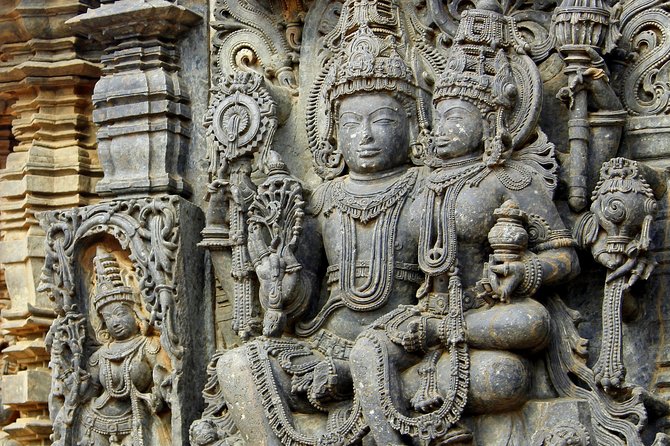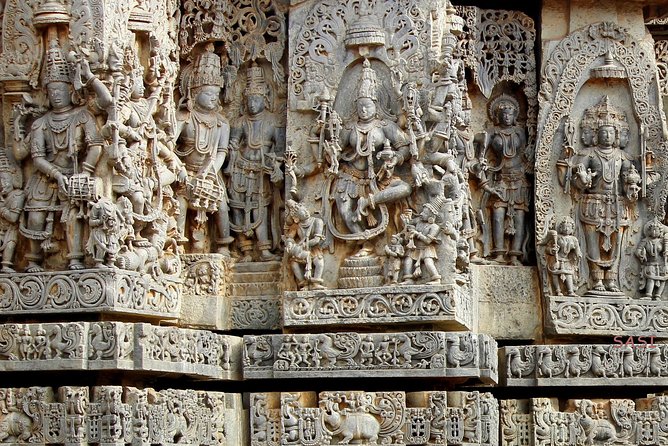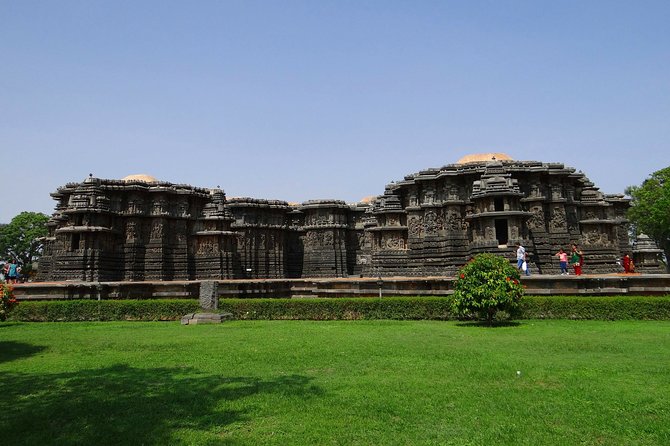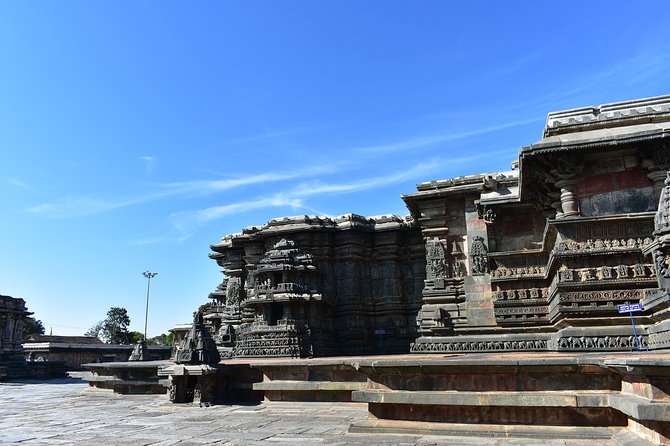Tucked away in the verdant landscapes of Karnataka, the ancient Hoysala temples of Belur and Halebidu beckon travelers seeking a glimpse into the exceptional architectural legacy of the region. Just a short distance from Bangalore, these 12th-century marvels boast intricate carvings and a unique blend of Dravidian and Vesara styles that captivate all who set eyes upon them. From the magnificent Chennakeshava Temple in Belur to the awe-inspiring Hoysaleswara Temple in Halebidu, the Hoysala dynasty’s exceptional craftsmanship is on full display, inviting visitors to uncover the stories etched in stone.
Good To Know

- A day tour from Bengaluru to the Hoysala architectural marvels of Belur and Halebidu, located approximately 175 km away, provides an opportunity to explore these 12th-century temple complexes.
- The Chennakeshava Temple in Belur and the Hoysaleswara Temple in Halebidu showcase the Hoysala dynasty’s exceptional craftsmanship, with intricate carvings and a unique blend of Dravidian and Vesara architectural styles.
- The tour includes private transportation and a local guide, allowing for a comprehensive experience and insights into the historical and cultural significance of these UNESCO World Heritage sites.
- Visitors are advised to arrive early to avoid crowds, wear comfortable shoes, and plan time to appreciate the intricate sculptural narratives that adorn the temple walls and structures.
- Extending the journey to the nearby town of Sravanbelagola, home to the world’s tallest monolithic statue of Bahubali, can further enrich the cultural experience of the Hoysala region.
Overview of Hoysala Architectural Marvels
The Hoysala temples of Belur and Halebidu stand as breathtaking architectural marvels, showcasing the ingenuity and craftsmanship of their builders.
Representing the zenith of Hoysala art and architecture, these 12th-century structures boast intricate carvings and splendid designs that improved upon the ornate styles of the Calukyas.
The Hoysalas artfully combined Dravidian and Vesara elements, creating a unique visual language.
Belur’s Chennakeshava Temple, built over a century, and Halebidu’s unfinished Hoysaleswara Temple, with its mesmerizing carvings, are testaments to the engineering prowess and aesthetic brilliance of the Hoysala dynasty.
These temples captivate visitors with their sheer scale, attention to detail, and historical significance.
You can also read our reviews of more tours and experiences in Bangalore.
Significance of Belur Chennakeshava Temple

Chennakeshava Temple in Belur stands as a remarkable embodiment of Hoysala architectural prowess.
Constructed in 1117 AD by King Vishnuvardhana, this magnificent temple was built to commemorate his victory over the Cholas.
The temple features lavish decorations and intricate carvings, showcasing the exceptional craftsmanship of the Hoysala artisans.
It took over 103 years to complete this architectural masterpiece, which is a testament to the dedication and skill of the builders.
The temple’s Dravidian and Vesara architectural styles, combined with the Hoysala’s unique elements, create a breathtaking visual display that continues to captivate visitors from around the world.
Splendor of Halebidu Hoysaleswara Temple

Situated in the former capital of the Hoysala Empire, the Hoysaleswara Temple in Halebidu stands as a remarkable testament to the architectural prowess and artistic mastery of this illustrious dynasty.
Dedicated to Lord Shiva, the temple’s construction spanned over 80 years, though it remains unfinished. Its intricate carvings depict a stunning array of deities, humans, animals, and scenes of war, hunting, music, and dance.
The richly ornamented temple showcases the Hoysalas’ exceptional attention to detail and their ability to seamlessly blend Dravidian and vesara styles.
Visitors are awed by the sheer scale and complexity of this engineering marvel, which continues to captivate art enthusiasts and historians alike.
Discovering Intriguing Sculptural Narratives

Hoysala sculptors’ masterful craftsmanship captivates visitors to the Belur and Halebidu temples, where intricately carved narratives unfold across the ornate façades.
On the walls, intricate bas-reliefs depict scenes from Hindu epics, mythological figures, and everyday life. Visitors can decipher the stories told through the sculptures, which range from the serene and divine to the dynamic and worldly.
These exquisite carvings showcase the technical virtuosity and artistic vision of the Hoysala artisans, who elevated temple design to new heights.
Exploring the temples is a journey through the rich cultural heritage of the Hoysala dynasty, preserved in the timeless artistry of these architectural marvels.
Exploring the Hoysala Dynasty’s Legacy
The Hoysala dynasty’s architectural and artistic legacy is magnificently preserved in the temples of Belur and Halebidu.
These Hindu temples, constructed between the 11th and 13th centuries, showcase the Hoysalas’ unique blend of Dravidian and Vesara styles.
The Chennakeshava Temple in Belur, built to commemorate a military victory, dazzles with its lavish decorations and intricate carvings depicting gods, humans, and scenes of daily life.
Similarly, the unfinished Hoysaleswara Temple in Halebidu impresses with its ornate sculptural narratives.
These engineering marvels continue to captivate art enthusiasts, offering a glimpse into the creative brilliance of the Hoysala era.
- Bangalore Through the Ages – Full-Day Tour With Lunch
- Experience Bangalore – City Tour, Authentic Food & Market (Food/Culture/History)
- Bengaluru Pete City Market Half-Day Walking Tour
- Full-Day Nandi Hills Countryside Tour by Bike
- Filter Kaapi Trail in Malleswaram- a Food Walk in Bangalore.
- Bandipur Sanctuary Tigers & Elephants
Logistics for the Temple Tour
Visitors can explore the magnificent Belur and Halebidu temples through a convenient day tour from Bengaluru. The tour includes private transportation, entry fees, a local guide, and meals.
Pickup is available from centrally located Bengaluru hotels with a start time of 6:00 AM. The tour is priced from $99.00, with the cost varying based on group size. Travelers can take advantage of the free cancellation policy up to 24 hours before the experience starts.
While the temples aren’t wheelchair accessible, most visitors can participate in the tour. The tour is operated by Discover Activities, and the temples are located approximately 175 km from Bengaluru.
Insider Tips for Optimal Experience
Maximizing one’s experience at the Belur and Halebidu temples requires a few insider tips.
Arrive early to beat the crowds and have more time to explore the intricate carvings at a leisurely pace.
Carry water and snacks, as the temples don’t have many refreshment options.
Wear comfortable shoes and sun protection, as the outdoor areas can be quite hot.
Extending the Journey to Sravanbelagola
While visiting the magnificent Belur and Halebidu temples, travelers can extend their journey to the nearby town of Sravanbelagola, a significant Jain pilgrimage site.
Just 110 km from Belur, Sravanbelagola is home to the world’s tallest monolithic statue of Bahubali, a revered Jain figure.
The town’s serene temples and meditation centers offer a perfect complement to the intricate carvings of the Hoysala temples.
Visitors can explore the ancient inscriptions, attend spiritual ceremonies, and soak in the calm atmosphere.
With convenient KSRTC bus connections, travelers can seamlessly combine the architectural marvels of Belur and Halebidu with the spiritual significance of Sravanbelagola for a well-rounded cultural experience.
Frequently Asked Questions
Are Guide Services and Meals Included in the Tour Package?
Yes, the tour package includes guide services and meals. According to the details provided, the tour includes private transportation, entry fees, a local guide, and meals as part of the package.
How Long Does the Temple Tour Typically Take to Complete?
The temple tour typically takes 6-8 hours to complete, allowing ample time to explore the intricate carvings, sculptures and architectural marvels of the Belur and Halebidu temples.
Are There Any Dress Code Requirements for Visiting the Temples?
There’s generally no strict dress code for visiting the Belur and Halebidu temples, but visitors should wear modest, comfortable clothing that covers the shoulders and knees out of respect for the religious sites.
Can Children Participate in the Temple Tour?
Yes, children can participate in the temple tour. The experience is suitable for most travelers, though the temples are not wheelchair accessible. Parents should supervise their children to ensure a safe and enjoyable visit.
Are There Any Photography Restrictions Inside the Temples?
There are no strict photography restrictions inside the temples, but visitors should refrain from using flash, avoid touching the sculptures, and respect the sanctity of the sacred spaces. Most photography is permitted for non-commercial purposes.
Sum Up
The Hoysala temples in Belur and Halebidu offer a captivating glimpse into the region’s architectural and cultural heritage. Visitors can enjoy the intricate carvings, unique blend of styles, and the legacy of the Hoysala dynasty. With easy accessibility from Bangalore, these UNESCO World Heritage sites provide a rewarding day trip that allows one to appreciate the exceptional craftsmanship and the enduring influence of the Hoysalas.
More Tour Reviews in Bangalore
Not for you? Here's more things to do in Bangalore we have recnetly reviewed
- 3 Best Dining Experiences In Bangalore
- 9 Best 2 Day Tours In Bangalore
- 3 Best Dinner Tours In Bangalore
- 14 Best Full-Day Tours In Bangalore
- 2 Best 3 Day Tours In Bangalore
- 2 Best 4 Day Tours In Bangalore
- 16 Best Lunch Experiences In Bangalore
- 8 Best Food Tours In Bangalore
- The Historic Trail of the Southern Region Review
- Bangalore Home Cooking Demonstration Review
- Architecture With Beach & Hills Review
- Bangalore: Helicopter Joyride With Panoramic City Views
